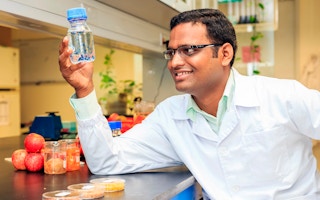The National University of Singapore (NUS) announced a scientific breakthrough last week that purified water using the peels of apples and tomatoes.
To continue reading, subscribe to Eco‑Business.
There's something for everyone. We offer a range of subscription plans.
- Access our stories and receive our Insights Weekly newsletter with the free EB Member plan.
- Unlock unlimited access to our content and archive with EB Circle.
- Publish your content with EB Premium.
Ramakrishna Mallampati, a PhD candidate of the university, developed this novel water treatment - a first in the world - to address the scarcity of potable water affecting large populations across the world.
According to UN-Water, 11 per cent of people worldwide, or 783 million people, are still without access to drinking water.
The statistics also showed that “in developing countries, 70 per cent of industrial waste is dumped untreated into waters where they pollute the usable water supply.”
This industry effluent release only adds to other hazardous pollutants that contaminate water sources. Such pollutants need to be removed before the water can be consumed. However, most water purification technologies are not accessible to economically disadvantaged people around the world.
NUS said the challenge for scientists is to develop robust water purification methods that could carry out water treatment at low cost, with minimal energy consumption and using less chemicals in the process so as to reduce negative impact on the environment.
To this end, the use of apple and tomato skins provides an accessible and cost-efficient solution to poor communities. Both peels – the former is easily available as biowaste from food processing industries and the latter is the second most consumed vegetable in the world – are highly effective adsorbents, removing different pollutants in the water.
Asked why these two particular edibles, Mallampati told Eco-Business: “In the quest of developing single adsorbent for all pollutants in water, we thought easily available and low cost biowaste will be efficient materials. We can use these peels for any kind of water but small modifications may require, if necessary.”
The modifications pertain to factors in the method, plus the nature of the tomato or apple peel. Several studies were conducted to analyse the structure of both peels and assess their efficiency in removing toxic metal ions and organic pollutants from water. Factors like the pH level, nature and amount of adsorbent used for extraction were also reviewed.
For apples, for example, Mallampati learned that zirconium-loaded apple peels were found to be able to extract anions such as phosphate, arsenate, arsenite, and chromate ions from aqueous solutions. On the other hand, tomato peels can effectively eliminate dissolved organic and inorganic chemicals, dyes and pesticides.
Mallampati said, “[The water treatment] works based on the adsorption process. The functional groups of chemical compounds in these peels adsorb different pollutants. The adsorption process may involve a combination of ligand exchange, complex formation and electrostatic attraction processes. Adding peels to water works to reduce contaminants, but complete elimination of all pollutants depends on different parameters including concentration and chemical nature of the pollutants.”
In time, Mallampati, who was under the supervision of associate professor Suresh Valiyaveettil from the Department of Chemistry, and the rest of the research team aim to apply their scientific discovery to real-life situations. They plan to partner with NGOs to help improve economically and technologically disadvantaged farmers living in far-flung villages.
The group also intend to study other fruit peels and natural fibres for more low-cost and waste-reducing water purification techniques.
The tomato and apple peel findings were published in the Royal Society of Chemistry journal RSC Advances in September 2012 and the American Chemical Society journal ASC Applied Materials & Interfaces last May.










